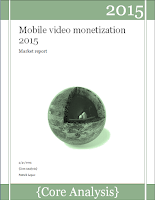Content providers and aggregators have obviously an interest (and in some case a legal obligation) to control the quality of the content they sell to a consumer. Without owning networks outright to deliver the content, they rent capacity, under specific service level agreements to deliver this content with managed Quality of Experience. When the content is delivered over the “free” internet or a mobile network, there is no QoE guarantee. As a result, content providers and aggregators tend to “push the envelope” and grab as much network resource as available to deliver a video stream, in an effort to equate speed and capacity to consumer QoE. This might work on fixed networks, but in mobile, where capacity is limited and variable, it causes congestion.
Obviously, delegating the selection of the quality of the content to a device should be a smart move. Since the content is played on the device, this is where there is the clearest understanding of instantaneous network capacity or congestion. Unfortunately, certain handset vendors, particularly those coming from the consumer electronics world do not have enough experience in wireless IP for efficient video delivery. Some devices for instance will go and grab the highest capacity available on the network, irrespective of the encoding of the video requested. So, for instance if the capacity at connection is 2Mbps and the video is encoded at 1Mbps, it will be downloaded at twice its rate. That is not a problem when the network is available, but as congestion creeps in, this behaviour snowballs and compounds congestion in embattled networks.
As more and more device manufacturers coming from the computing world (as opposed to mobile) enter the market with smartphones and tablets, we see wide variations in the implementation of their native video player.
Consequently, operators are looking at way to control video traffic as a means to maybe be able to monetize it differently in the future. Control can take many different aspects and rely on many technologies ranging from relatively passive to increasingly obtrusive and aggressive.
In any case, the rationale for implementing video control technologies in mobile networks goes beyond the research for the best delivery model. At this point in time, the actors have equal footing and equal interest in preserving users QoE. They have elected to try and take control of the value chain independently. This has resulted in a variety of low level battles, where each side is trying to assert control over the others.
The proofs of these battles are multiple:
- Google tries to impose VP9 as an alternative to H.265 /HEVC: While the internet giant rationale to provide a royalty-free codec as the next high efficiency codec seems innocuous to some, it is a means to control the value chain. If content providers start to use VP9 instead of H.265, Google will have the means to durably influence the roadmap to deliver video content over the internet.
- Orange extracts peering fees from Google / YouTube in Africa: Orange as a dominant position for mobile networks and backhaul in Africa and has been able to force Google to the negotiating table and get them to pay peering fee for delivering YouTube over wireless networks. A world’s first.
- Network operators implement video optimization technologies: In order to keep control of the OTT videos delivered on their networks, network operators have deployed video optimization engine to reduce the volume of traffic, to alleviate congestion or more generally to keep a firmer grip on the type of traffic transiting their networks.
- Encryption as an obfuscation mechanism: Content or protocol encryption has traditionally been a means to protect sensitive content from interception, reproduction or manipulation. There is a certain cost and latency involved in the encoding and decoding of the content, so it has remained mostly used for premium video. Lately, content providers have been experimenting with the delivery of encrypted video as a means to obfuscate the traffic and stop network operators from interfering with it.
- Net neutrality debate, when pushed by large content providers and aggregators is oftentimes a proxy for commercial battle. Th economics of the internet have evolved from browsing to streaming and video has disrupted the models significantly. The service level agreements put in place by the distribution chains (CDNs, peering points...) are somewhat inadequate for video delivery.
We could go on and on listing all the ways that content providers and network operators are probing each other’s capacity to remain in control of the user’s video experience. Ultimately, these initiatives are isolated but are signs of large market forces trying to establish dominance over each other. So far, these manoeuvres have reduced the user experience. The market will settle in a more collaborative mode undoubtedly as the current behaviour could lead to mutually assured destruction. The reality is simple. There is a huge appetite for online video. An increasing part of it takes place on mobile devices, on cellular networks. There is money to be made if there is collaboration, the size of the players is too large to establish a durable dominance without vertical integration.



